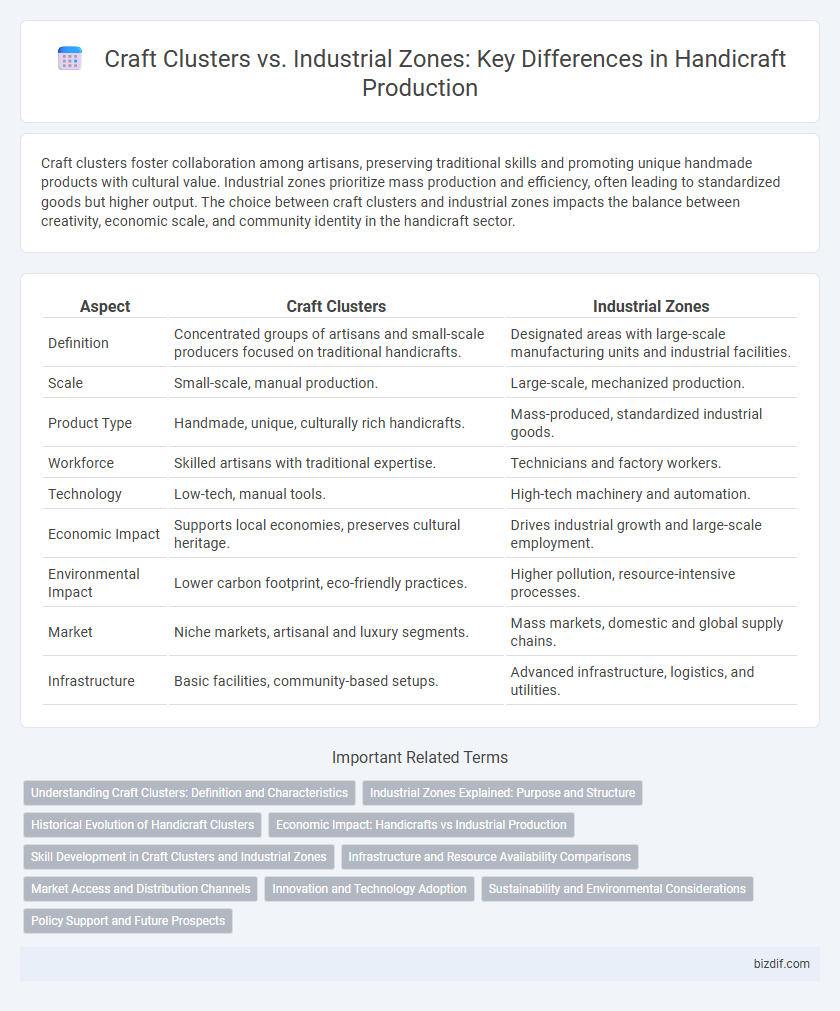Craft clusters foster collaboration among artisans, preserving traditional skills and promoting unique handmade products with cultural value. Industrial zones prioritize mass production and efficiency, often leading to standardized goods but higher output. The choice between craft clusters and industrial zones impacts the balance between creativity, economic scale, and community identity in the handicraft sector.
Table of Comparison
| Aspect | Craft Clusters | Industrial Zones |
|---|---|---|
| Definition | Concentrated groups of artisans and small-scale producers focused on traditional handicrafts. | Designated areas with large-scale manufacturing units and industrial facilities. |
| Scale | Small-scale, manual production. | Large-scale, mechanized production. |
| Product Type | Handmade, unique, culturally rich handicrafts. | Mass-produced, standardized industrial goods. |
| Workforce | Skilled artisans with traditional expertise. | Technicians and factory workers. |
| Technology | Low-tech, manual tools. | High-tech machinery and automation. |
| Economic Impact | Supports local economies, preserves cultural heritage. | Drives industrial growth and large-scale employment. |
| Environmental Impact | Lower carbon footprint, eco-friendly practices. | Higher pollution, resource-intensive processes. |
| Market | Niche markets, artisanal and luxury segments. | Mass markets, domestic and global supply chains. |
| Infrastructure | Basic facilities, community-based setups. | Advanced infrastructure, logistics, and utilities. |
Understanding Craft Clusters: Definition and Characteristics
Craft clusters are geographic concentrations of artisans and small-scale producers specializing in traditional handicrafts, characterized by shared knowledge, resources, and cultural heritage. These clusters foster innovation, skill development, and market access through close collaboration and social networks, differentiating them from industrial zones focused on mass production and standardized processes. Understanding the unique social capital and localized economies of craft clusters is essential for promoting sustainable craftsmanship and preserving cultural identities.
Industrial Zones Explained: Purpose and Structure
Industrial zones are designated areas specifically planned to support large-scale manufacturing and industrial activities, providing essential infrastructure such as transportation links, utilities, and waste management systems. These zones promote efficiency by grouping similar industries together, facilitating supply chain integration and economies of scale. Unlike craft clusters, which emphasize artisanal skills and local traditions, industrial zones prioritize mass production and mechanization to meet high-volume market demands.
Historical Evolution of Handicraft Clusters
Handicraft clusters historically evolved as localized hubs where artisans shared resources, skills, and market access, fostering cultural heritage and regional identity. Unlike industrial zones designed for mass production and economic scale, these clusters emphasize craftsmanship, tradition, and community collaboration. Over centuries, such clusters adapted to changing economic patterns while preserving unique artisanal techniques and sustaining rural economies worldwide.
Economic Impact: Handicrafts vs Industrial Production
Craft clusters generate significant economic benefits by fostering local entrepreneurship, preserving traditional skills, and enabling flexible production tailored to niche markets. Industrial zones drive large-scale economic growth through mass production, higher output, and export capacity, but often at the expense of artisanal quality and cultural heritage. The economic impact of handicrafts lies in sustainable livelihoods and cultural value, while industrial production prioritizes efficiency, scale, and global competitiveness.
Skill Development in Craft Clusters and Industrial Zones
Craft clusters foster skill development through traditional techniques passed down generations, enhancing artisans' specialized craftsmanship and cultural heritage preservation. Industrial zones emphasize formal training programs and technological integration, equipping workers with modern manufacturing skills and improving productivity. Both environments contribute to workforce competency but differ in approach, with craft clusters nurturing artisanal skills and industrial zones promoting industrial efficiency.
Infrastructure and Resource Availability Comparisons
Craft clusters typically benefit from localized infrastructure tailored to small-scale artisans, including shared tools, materials, and community workshops that optimize resource accessibility. Industrial zones offer large-scale, standardized facilities designed to support mass production, with advanced machinery, extensive supply chains, and logistics networks that ensure efficient material flow. Resource availability in craft clusters often emphasizes traditional materials and skilled labor pooling, while industrial zones prioritize bulk raw materials and mechanized processes.
Market Access and Distribution Channels
Craft clusters foster localized networks that enhance market access for artisans through direct community engagement and niche demand, while industrial zones prioritize large-scale production with streamlined distribution channels targeting mass markets. The decentralized nature of craft clusters supports personalized customer relationships and adaptive marketing strategies, contrasting with industrial zones' reliance on standardized logistics and wholesale distribution. Efficient distribution in industrial zones enables faster market reach but often limits artisan visibility compared to the culturally rich environments of craft clusters.
Innovation and Technology Adoption
Craft clusters enhance innovation in handicrafts by fostering close collaboration among artisans, which accelerates knowledge exchange and the development of unique, high-quality products. These clusters typically integrate traditional techniques with modern tools, facilitating gradual technology adoption while preserving cultural authenticity. In contrast, industrial zones emphasize large-scale production, often prioritizing efficiency and automation over artisanal innovation and personalized craftsmanship.
Sustainability and Environmental Considerations
Craft clusters promote sustainability through localized production processes that minimize waste and energy use, contrasting with industrial zones where large-scale operations often generate higher emissions and resource depletion. Handicraft clusters rely on traditional, eco-friendly materials and techniques, supporting circular economy principles by reusing and recycling resources within community networks. Environmental considerations prioritize these clusters for preserving biodiversity and reducing carbon footprints compared to industrial zones dominated by mechanized, pollution-intensive manufacturing.
Policy Support and Future Prospects
Craft clusters benefit from targeted policy support such as subsidies, skill development programs, and marketing assistance that preserve traditional techniques while fostering innovation. Industrial zones emphasize infrastructure, large-scale production incentives, and streamlined regulations to enhance mass manufacturing efficiency. Future prospects for craft clusters include niche market growth and cultural tourism integration, whereas industrial zones aim for technological upgrades and export expansion.
Craft Clusters vs Industrial Zones Infographic

 bizdif.com
bizdif.com